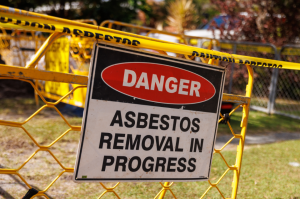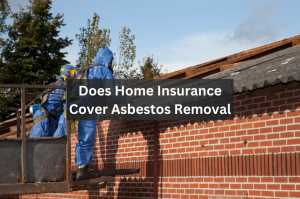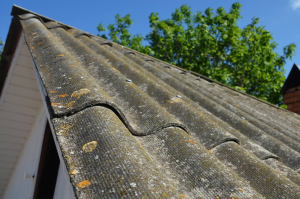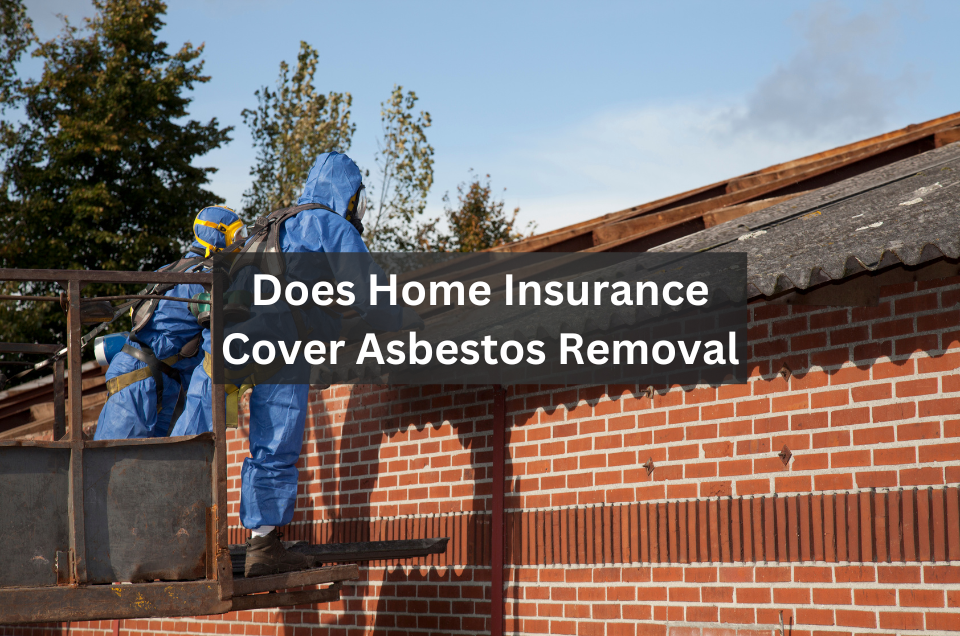Asbestos removal is essential for maintaining a safe home, but it’s important to know that home insurance often doesn’t cover this cost. Most UK policies exclude asbestos removal unless it’s linked to damage caused by an insured event, such as a fire or storm. This leaves many homeowners responsible for the expense, which can range between £1,500 and £3,000 for moderate projects, depending on the size and location of the affected area.
Buildings constructed before 2000 are especially at risk, as they are more likely to contain asbestos. Each year, over 5,000 asbestos-related deaths occur in the UK, making safe and professional removal a top priority.
At Crown Asbestos Removal, we provide licensed and eco-friendly services to remove asbestos safely. While based in Australia, our expertise and proven methods set us apart, ensuring your home is asbestos-free and safe for your family. Here in this page we’ll teach you in detail how home insurance covers Asbestos removal in Australia and the UK.
What Is Asbestos and Why Is It Dangerous?
 Asbestos is a naturally occurring mineral made of fine, durable fibers that are resistant to heat, fire, and chemicals. Because of these qualities, asbestos was used for decades in a wide range of building materials, including insulation, roofing, flooring, cement, and even decorative finishes. Builders often chose asbestos for its strength, low cost, and ability to withstand high temperatures. In fact, for much of the 20th century, it was considered the perfect material for construction projects, from homes to large commercial buildings.
Asbestos is a naturally occurring mineral made of fine, durable fibers that are resistant to heat, fire, and chemicals. Because of these qualities, asbestos was used for decades in a wide range of building materials, including insulation, roofing, flooring, cement, and even decorative finishes. Builders often chose asbestos for its strength, low cost, and ability to withstand high temperatures. In fact, for much of the 20th century, it was considered the perfect material for construction projects, from homes to large commercial buildings.
However, as time went on, experts discovered that asbestos posed serious health risks when its fibers were released into the air. This often happened during construction, renovation, or natural wear and tear. Once the fibers are disturbed and become airborne, they can easily be inhaled or swallowed, leading to long-term health issues. The fibers are so small that they can get trapped in the lungs or other parts of the body, causing damage over time.
Asbestos is dangerous because it’s nearly impossible to detect with the naked eye when it’s releasing harmful fibers. If your home was built before the 1980s, there’s a chance that asbestos-containing materials (ACMs) are present, and they could be a hidden health threat.
The Health Risks of Asbestos Exposure
Asbestos exposure can lead to several serious health conditions, some of which may not show symptoms until many years later. According to the WHO, around 125 million people are exposed to asbestos at the workplace worldwide every year. It’s one of the most significant causes of lung-related diseases.
- Asbestosis: This chronic lung disease occurs when inhaled asbestos fibers cause scarring in the lung tissue, making it hard to breathe. According to the American Lung Association, asbestosis can lead to permanent lung damage and can be fatal if left untreated. More than 10,000 deaths annually in the US are related to asbestos exposure.
- Lung Cancer: People who are exposed to asbestos have a much higher risk of developing lung cancer, particularly if they smoke. According to the National Cancer Institute, those exposed to asbestos are five times more likely to develop lung cancer than people who aren’t exposed. In fact, lung cancer deaths related to asbestos are estimated to be in the thousands annually.
- Mesothelioma: This is a rare and aggressive form of cancer linked exclusively to asbestos exposure. It typically affects the lining of the lungs, abdomen, or heart. The American Cancer Society states that mesothelioma is almost always caused by exposure to asbestos, and the survival rate is low-most people diagnosed with mesothelioma live for only 12 to 21 months after diagnosis.
- Other Respiratory Diseases: Prolonged exposure to asbestos can lead to other lung diseases like pleural plaques, lung scarring, and a condition called pleural effusion, which is the buildup of fluid around the lungs.
Even brief or low-level exposure can cause serious harm. The National Institute for Occupational Safety and Health (NIOSH) has found that no level of asbestos exposure is considered safe.
Why You Should Remove Asbestos from Your Property
Removing asbestos from your property is crucial to protect your health and the health of your family. While asbestos that is undamaged and in good condition may not immediately release harmful fibers, it is still a risk. When materials containing asbestos get damaged or disturbed, the fibers can easily escape into the air, especially during renovations, repairs, or if the material is old and deteriorating.
If you live in a home built before the 1980s, there’s a higher chance that your property contains asbestos-containing materials (ACMs). According to the Health and Safety Executive (HSE), asbestos exposure is responsible for approximately 5,000 deaths in the UK every year, which is why proper removal is so important.
It’s important to act quickly if you suspect that your home contains asbestos. Professionals like Crown Asbestos Removal can safely assess your property and remove any hazardous materials. They use the latest techniques to ensure your home is free from the risks of asbestos exposure.
Removing asbestos from your property ensures that you, your family, and anyone visiting your home aren’t exposed to these harmful fibers. Crown Asbestos Removal, based in Australia, can help guide you through the process and ensure that your property is safe. With their expert team, you can be confident that your home is in good hands.
Ensuring the safety of your family begins with understanding the risks of asbestos exposure and acting promptly to remove it. Don’t take chances with your health-contact certified asbestos removal experts to make sure your home is safe for everyone.
Does Home Insurance Cover Asbestos Removal?

Home insurance is designed to protect your property from damage caused by unexpected events, like fires, storms, or theft. It typically covers the structure of your home, as well as your personal belongings inside. For example, if your home catches fire, home insurance will help pay for the repairs. Similarly, if a storm causes damage to your roof or windows, your insurance might cover the cost to fix it.
However, when it comes to asbestos removal, things can get more complicated. Asbestos is a harmful material that was widely used in homes for insulation and other purposes, but it was banned in many places due to health concerns. Asbestos removal is the process of safely getting rid of this material from your property. Unfortunately, most home insurance policies do not cover asbestos removal because it’s often considered a pre-existing condition. This means that if your home already contains asbestos, insurance companies view it as something that existed before the insurance coverage began, and therefore, they won’t cover the removal.
Despite this, there are a few situations where home insurance may help with asbestos removal. If the asbestos is disturbed or exposed during an insured event, such as a fire or storm, insurance might cover some of the removal and repair costs. For example, if a fire damages your home and exposes asbestos that was previously hidden, your insurance may cover the costs of both removing the asbestos and repairing the damage to your home.
When Home Insurance Covers Asbestos Removal
In other words, if asbestos becomes an issue because of an accident or damage, insurance could step in to help. However, if the asbestos was just discovered as part of regular home maintenance or renovation, insurance will most likely not cover it.
Some homeowners might think that their home insurance will help with asbestos removal, but it’s crucial to check your policy. Many people are surprised to learn that asbestos removal is not typically covered under their standard policy. If you find asbestos during a renovation or repair, most insurance policies will not cover the removal costs, even if the asbestos was uncovered due to structural damage.
For homeowners it’s important to understand that home insurance coverage for asbestos removal in the UK can vary greatly between different providers.
It’s also important to note that asbestos removal can be very expensive. The cost can range from £300 to £1,000 or more per room depending on the amount of asbestos present, the type of material, and the complexity of the removal process. Therefore, knowing whether your insurance covers these costs is critical to avoid unexpected expenses.
In many cases, if your home insurance doesn’t cover asbestos removal, you will need to find other options. You might have to pay for the removal out of pocket, or look for specialized asbestos removal insurance if available. In some instances, government programs or grants might help with the costs, especially for older homes.
Always consult with a licensed asbestos removal expert to ensure the work is done safely and to understand all your options. The removal of asbestos should only be carried out by certified professionals who follow the proper procedures to protect your health and the environment.
Factors That Determine If Asbestos Removal Is Covered by Home Insurance
Determining whether your home insurance will cover asbestos removal can feel tricky, as policies vary greatly. Insurers often consider multiple factors before deciding. Below are the most important aspects that influence whether your claim will be accepted.
1. The Insurance Provider’s Policies
Every insurance company has its own rules about what is and isn’t covered. Generally, asbestos removal is excluded from standard home insurance policies in the UK, unless it is linked to an event covered by your policy, such as a fire, flood, or storm damage.
For example, if a flood damages your walls and exposes asbestos, some insurers may cover the removal as part of the overall repair claim. However, if the asbestos issue existed before the flood, it would likely be excluded.
Recent data shows that 70% of home insurance providers in the UK exclude asbestos removal from their policies, while only 30% offer partial coverage under specific circumstances. Always review your insurance documents carefully to understand these details.
2. The Cause of Asbestos Exposure or Damage
Insurance companies closely examine the cause of the asbestos problem to determine if it qualifies for coverage.
If the issue arises from an unexpected and accidental event, such as a house fire or storm, insurers are more likely to approve the claim. For instance, if a fire damages your ceiling, and asbestos insulation is exposed, the removal could be covered.
However, if the asbestos problem is due to long-term neglect, such as aging materials breaking down, the claim is almost always rejected. According to recent UK industry reports, only 15% of asbestos-related claims linked to sudden events are approved, while nearly 85% of claims tied to gradual issues are denied.
3. Whether the Issue Is Sudden or Long-Standing
One of the most significant factors is whether the asbestos issue is considered sudden or pre-existing.
- Sudden Issues: Asbestos exposure caused by a recent event (e.g., a severe storm or accidental discovery during renovations) is more likely to be considered for coverage.
- Pre-Existing Conditions: If asbestos has been present for years due to outdated materials, insurers typically classify it as a homeowner’s responsibility, not their own.
For example, if you buy an older home where asbestos has been present since construction, this is seen as a pre-existing condition. In the UK, 85% of home insurance claims related to pre-existing asbestos issues are rejected because insurers expect homeowners to address these risks proactively.
Asbestos Coverage Statistics in the UK
| Factor | Percentage of Insurers Covering It |
| Asbestos removal caused by a fire or flood | 40% |
| Sudden asbestos exposure (unexpected events) | 30-40% |
| Long-standing asbestos problems | 15% |
| General asbestos removal (not event-related) | 0-5% |
| Claims rejected for gradual deterioration | 85% |
Understanding these factors can save you time and frustration when dealing with asbestos issues. While insurance policies are often limited in covering asbestos removal, knowing the rules can help you decide whether a claim is worth filing or if alternative solutions are needed. Always reach out to your insurance provider for clarification and consult licensed professionals to safely handle asbestos in your home.
What to Do If Your Insurance Doesn’t Cover Asbestos Removal

If your home insurance doesn’t cover asbestos removal, you’re not alone. Many homeowners face this challenge because most insurance providers in the UK consider asbestos removal a maintenance issue rather than an insured event. However, there are practical and affordable ways to handle this issue effectively while keeping your property safe.
1. Consult a Licensed Company for Professional Advice
The first step is to seek help from a licensed asbestos removal company. Professionals ensure the process is safe and follows government guidelines. Companies like Crown Asbestos Removal, while based in Australia, set industry standards with their proven methods and certified experts. According to UK safety standards, all asbestos removal must comply with Control of Asbestos Regulations 2012, ensuring safety for both workers and residents.
Statistics show that 70% of asbestos-related illnesses come from prolonged exposure during DIY removals. This highlights the importance of professional handling.
2. Explore Government Grants or Assistance Programs
In the UK, homeowners may qualify for government assistance if asbestos poses a public health risk. Some local councils offer grants for low-income households to cover the costs of inspection and removal. While not all grants cover the full expense, they can reduce the financial burden significantly. For example, certain grants can contribute up to 50% of the total removal costs, depending on the region and property risk level.
3. Compare Quotes from Certified Experts
Hiring certified asbestos removal professionals is critical, but costs can vary widely. On average, asbestos removal in the UK costs between £50 to £150 per square meter, depending on the material’s type and location. Comparing quotes from multiple companies helps you find the best deal without compromising on safety. Always ensure the contractors are accredited by organizations such as the UK Asbestos Training Association (UKATA).
| Asbestos Removal Costs in the UK | Cost Range |
| Small Removal (e.g., tiles) | £500 – £1,000 |
| Moderate Removal (e.g., walls, pipes) | £1,000 – £2,500 |
| Full House Removal | £8,000 – £15,000 |
4. Use Eco-Friendly and Certified Methods
Safe and eco-friendly methods are a must when dealing with asbestos. Certified professionals follow strict procedures to ensure that asbestos waste is properly disposed of at licensed facilities. Improper handling can lead to fines of up to £20,000 under UK law. This is why choosing a certified and environmentally responsible team is crucial.
Asbestos-related diseases like mesothelioma and asbestosis claim over 5,000 lives annually in the UK, making it a critical health risk. DIY removal can release dangerous airborne fibers, posing immediate and long-term threats to your family’s health.
This is where Crown Asbestos Removal steps in. Our certified team ensures safe, thorough asbestos removal, following strict regulations to protect your property and health. While insurance may not always cover removal, working with trusted professionals like us guarantees a safe and cost-effective solution.
Why Choose Crown Asbestos Removal for Expert Advice
When it comes to asbestos removal, you want to work with professionals who have the right experience and follow the safest procedures. Even though Crown Asbestos Removal operates in Australia, our proven process and dedication to safety make us a reliable guide for those facing asbestos issues, no matter where they are. Our team understands the seriousness of dealing with asbestos, and we are committed to providing top-quality service that inspires confidence.
Our approach is safety-first, ensuring every step, from inspection to disposal, is carried out with the utmost care. This means using the best equipment, following strict safety guidelines, and ensuring no harm comes to you, your family. We also believe in environmental responsibility-the methods we use for asbestos removal and disposal are designed to be safe for the planet, leaving behind as little impact as possible. Our team of highly trained professionals is fully licensed and insured, offering you peace of mind that the job will be done right. With years of experience in handling asbestos removal services, our certified specialists are equipped to tackle even the most challenging situations.
Final Thoughts
Understanding whether home insurance covers asbestos removal can be confusing, but it’s essential for homeowners to know their options. Some insurance policies may not cover asbestos removal costs, especially if its presence was known beforehand. There are still ways to handle the situation safely and efficiently. Even if your insurance doesn’t cover asbestos removal, there are solutions available to you. You can look into government grants or financial assistance, and most importantly, you should contact a licensed asbestos removal specialist to ensure the job is done properly.
yle=”font-weight: 400;”>Remember, asbestos removal is not something you should handle alone. It’s dangerous, and improper removal can result in serious health risks. Having professionals with the right knowledge and equipment is crucial. Insurance coverage may vary, but safely addressing asbestos should always be a priority for your home and family’s well-being.
